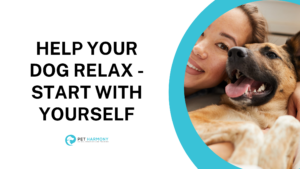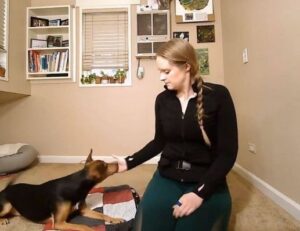
Relaxation is a staple topic in many of my sessions with clients. Being able to take a load off, fill your cup, get true rest, and be able to self-regulate is a huge part of having mental, physical, and behavioral health. It’s so important that “calming” is its own category of needs in Canine Enrichment for the Real World and the Pet Harmony Enrichment Framework.
There are a ton of ways to help your dog learn relaxation skills (some of which will be linked below), but the focus of this blog isn’t centered on getting your dog the skills. This one talks about the human end of the leash, and what we can do to help them.
Let me tell you a story, I promise there is a reason.
Years ago, I never put much weight on the idea that dogs “get our energy”, and that is a whole blog post of its own. That was, however, until we were looking to get Griffey a pet sitter.
For those of you that don’t know me (Hi! I’m Ellen!), and my dog, Griffey, came into our family with lots of capital B, capital F, Big Feels. He was scared of other dogs, fearful of strangers, showed some Separation Related Problems, wasn’t potty trained, and got sick in the car. We had made a lot of progress on the separation skills, got him very well potty trained, was doing great in the car, building some relationships with people, but was still scared of other dogs, so he would be considered a “special care needs” dog.

At the time, we were living in Seattle and ready to start finding him pet care so that we could continue to travel. Through our incredible network, we were able to find a pet sitter that opened their home to reactive dogs. They had created a wonderful environment for dog reactive dogs. They wouldn’t go for walks, but they had options for in-home or in the yard exercise. The dogs would only be home alone a couple of hours a day and pets were welcomed into the home like they were one of the family. The pet sitter had incredible skills in terms of body language, observation, and training. It was the perfect setup for our needs, and the pet sitter required gradual exposure to them, their home, and the stays, which we were looking for.
As you can probably imagine, I was a little stressed. I REALLY wanted this to go well. Traveling was something that was important for my partner and me to refill our cups and be our best selves, as well as get our continuing education via conferences.
During our first visit…
We were all just going to hang out and chat while we saw if Griffey would be able to settle in their home while we were present and supporting him. As Griffey was milling around and exploring, the rest of us were sitting on the couches, chatting it up. He was being a busy bee, which isn’t surprising given all the new things to explore, smell, and experience.
After about 20-30 minutes, he still wasn’t slowing down.
The pet sitter looked at me and said, “You seem a little tense. How about you try to sit back, put your feet up, settle into the couch, take a deep breath, maybe yawn, and see what happens.”
And I thought to myself, “I would rather die than put my feet on a stranger’s furniture, I absolutely cannot, but I will.”
So, I did. I scooted back into the couch. I sat as I would at home, I took a big deep breath, forced a yawn, and tried to sink into the couch.
Griffey came back to the room and looked at me.
He looked at my partner.
He looked at the pet sitter.
He looked back at me.
He jumped on the couch, found a blanket, made a bed, laid down, let out a big sigh, and started to get droopy eyes.
And I learned something, or maybe solidified something that day.
We can get in the way of our dog relaxing.
When working with families on teaching their dog(s) relaxation, I often get questions or statements like…
“He’s staring so intently at me.”
“He’s on his mat, but he doesn’t look relaxed. He’s still tense.”
So often, when working on teaching a dog to relax, we as well-intentioned humans will fail to be relaxed. We will be focused. We will be staring. Our body language may indicate that activities are on the horizon. We may even hold our breath waiting for the dog to do the thing.
And you know how a lot of dogs respond? By mirroring that back. You may see them laying very erect in a sphynx down, focused on their person, their breathing may be rhythmic, but very shallow. They might engage with you waiting for more information.
If this sounds like you, turn toward yourself and see how you are holding yourself.
Are your shoulders up to your ears? How much tension is in your back? How is your breathing? Are you staring?
Try re-setting yourself. Take a deep breath. Shake it off. Drop your shoulders. Instead of staring at your dog, try looking out of your periphery, or watching your dog in a reflection.
When I suggest these changes to families, they usually come back stunned at what a difference it makes in their dog’s ability to settle.
You might be surprised what a difference it can make.
Now What?
- If you’re already practicing relaxation with your pet, check on your own body language! Is it influencing how your pet is engaging with that activity?
- If you are looking for some great resources around practicing relaxation, check out some of these:
- Podcasts:
- Youtube Videos:
Happy Training!
Ellen
